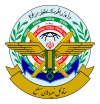This is an old revision of this page, as edited by KolbertBot (talk | contribs) at 09:32, 5 April 2018 (Bot: HTTP→HTTPS (v485)). The present address (URL) is a permanent link to this revision, which may differ significantly from the current revision.
Revision as of 09:32, 5 April 2018 by KolbertBot (talk | contribs) (Bot: HTTP→HTTPS (v485))(diff) ← Previous revision | Latest revision (diff) | Newer revision → (diff) This article describes the Iranian missile Ghadr-110. For other uses of the term Ghadr, see Ghadar (disambiguation). Strategic MRBM| Ghadr-110 | |
|---|---|
 Ghadr ballistic missiles (8 March 2016) Ghadr ballistic missiles (8 March 2016) | |
| Type | Strategic MRBM |
| Service history | |
| Used by | Iran |
| Production history | |
| Manufacturer | Iran |
| Specifications | |
| Warhead | One |
| Engine | First stage liquid, Second stage solid |
| Operational range | 1,800–2,000 km |
The Ghadr-110 (Persian: قدر-110, meaning "intensity") is a medium-range ballistic missile designed and developed by Iran. The missile has a range of 1,800 km to 2,000 km. The Iranian Armed Forces first displayed the missile to the public at an annual military parade to mark the Iran-Iraq war.
The Ghadr-110 is an improved version of the Shahab-3A, also known as the Ghadr-101. It is believed to have a liquid-fuel first stage and a solid-fuel second stage, which allows it to have a range of 1,500 km (930 mi).
The Ghadr-110 has a higher maneuverability and a shorter set-up time than the Shahab-3; its set-up time is 30 minutes while the older Shahab-3 has a set-up time of several hours. The missile has been manufactured entirely in Iran at the top-secret Hemmat Missile Industries Complex.
On November 21, 2015 and January 29, 2017, Iran reportedly carried out launches of the Ghadr 110. The United States viewed this as a violation of United Nations Security Council Resolution 2231 which "calls upon" Iran to not work on any ballistic missiles capable of carrying nuclear warheads, including launching them. Russia's ambassador to the UN disputed this, saying "a call is different from a ban, so legally you cannot violate a call, you can comply with a call or you can ignore the call, but you cannot violate a call". Iran's foreign minister, Javad Zarif, responded by saying that since Iran does not possess nuclear weapons nor does it ever intend to have one, it does not design its missiles to be capable of carrying nuclear warheads.
See also
- Military of Iran
- Air Force of the Army of the Guardians of the Islamic Revolution - controls Iran's missile forces
- Iranian military industry
References
- ^ Fars News Agency Archived February 6, 2012, at the Wayback Machine
- RFERL - Iranian military parade
- CSIS Missile Threat
- "Iran sends defiant signal to the West with missile test". The Daily Telegraph. Dec 9, 2015.
- https://www.reuters.com/article/us-iran-missiles-un-idUSKCN0WG1NG
- https://www.youtube.com/watch?v=A8y9-VjXnBE
| Armed Forces |
|  | ||||||||||||||
|---|---|---|---|---|---|---|---|---|---|---|---|---|---|---|---|---|
| Other | ||||||||||||||||